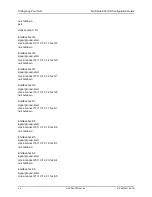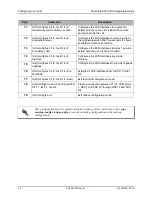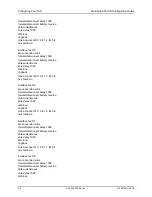
Configuring Your IAD
NetVanta 950 IAD Configuration Guide
18
© 2004 ADTRAN, Inc.
61200788L1-29.1B
For additional information about the available settings for the FXS card, see
All other interface configuration options are dependent on the type of signaling used. These settings
are described in the Signaling section. See the
AOS Command Reference Guide
for a complete list of
all FXS commands, or type
?
at the prompt.
Signaling
Loop start signaling bridges tip and ring to indicate an off-hook (seizing the line) condition. Ground
start signaling applies resistance to the tip conductor of the circuit to indicate an off-hook (seizing the
line) condition. The signaling mode must match the configuration of the network and the expected
operation with customer premises equipment. The FXS ports are set for loop start signaling by default.
The other option is ground start signaling. To change the signaling type to ground start, type
signal
ground-start
.
E&M Tandem conversion is a setting used to convert E&M signaling on a T1 to FXS loop start or
ground start signaling. The
em-conversion
command has two possible settings,
immediate
and
wink
.
Type
em-conversion immediate
to transmit DTMF digits toward the 2-wire interface immediately
following an off-hook condition. Type
em-conversion wink
to implement a wink process for inbound
calls. Use the
no
command to disable
em-conversion
(em-conversion is disabled by default).
There are several other settings that are only valid if E&M Conversion is enabled. These include
dial-tone
,
dnis-delay
,
dnis-wink-timeout
,
forward-disconnect delay
,
forward-disconnect battery
,
and
ringback
. Type
dial-tone
to enable dial-tone and type
ringback
to enable ringback. They should
be enabled whenever the central office switch does not provide those features. They are only necessary
in E&M applications and
em-conversion
must be configured.
The
dnis-delay
and
dnis-wink-timeout
commands are used in conjunction with the
em-conversion
wink
setting. Use
dnis-delay
to define the time delay after transmitting a wink in response to the
2-wire interface going off-hook (after ringing) before transmitting off-hook towards the T1 interface.
Dnis-delay
is only valid when
em-conversion
is configured for wink. By default,
dnis-delay
is
disabled. The no version of this command disables
dnis-delay
. Possible settings range from 500 ms to
3000 ms in 500 ms increments. For example, type
dnis-delay
1500
to set the delay to 1.5 seconds.
When
dnis-delay
is specified and
dnis-wink-timeout
is enabled, a wink is returned to the originating
switch after five seconds if the port does not detect an off-hook condition. Disabling this option allows
the FXS port to ring without winking until the call is answered. By default this option is enabled when
dnis-delay
is activated.
.
Finally,
forward-disconnect delay
and
forward-disconnect battery
are used together to define the
actions of the FXS port when the remote equipment ends the call. Both commands are disabled by
default and are only used when the interface is configured for
loop-start
and
em-conversion
is
enabled. The
forward-disconnect delay
specifies the number of milliseconds the FXS module waits
after initiating a disconnect sequence on the FXS interface as a result of remote end terminating the
call, before returning to an idle condition. By default,
forward-disconnect delay
is disabled. If
Trunks may be taken out of service by the central office switch if no wink is received. Use
caution when disabling this option.
















































